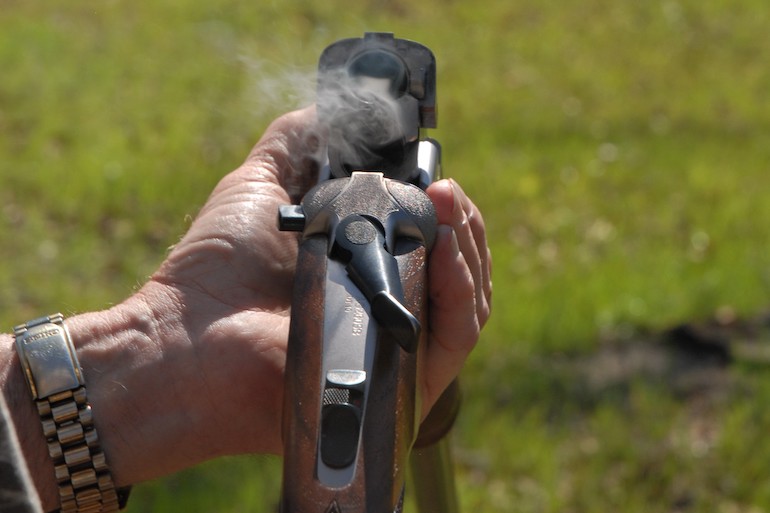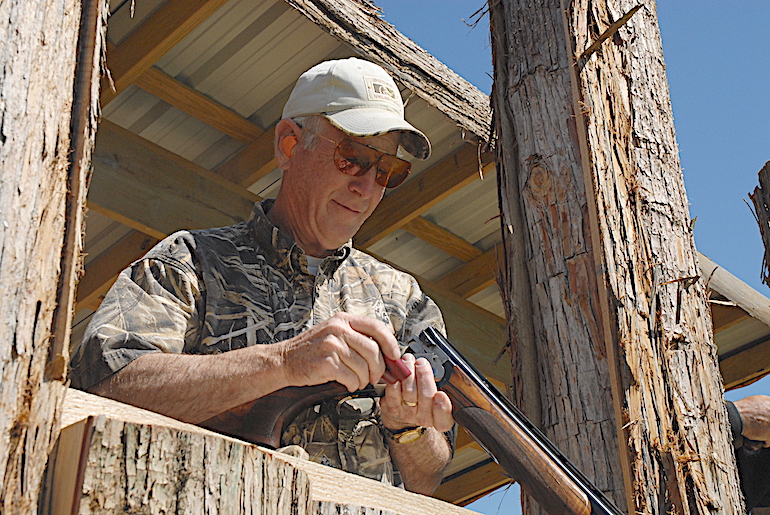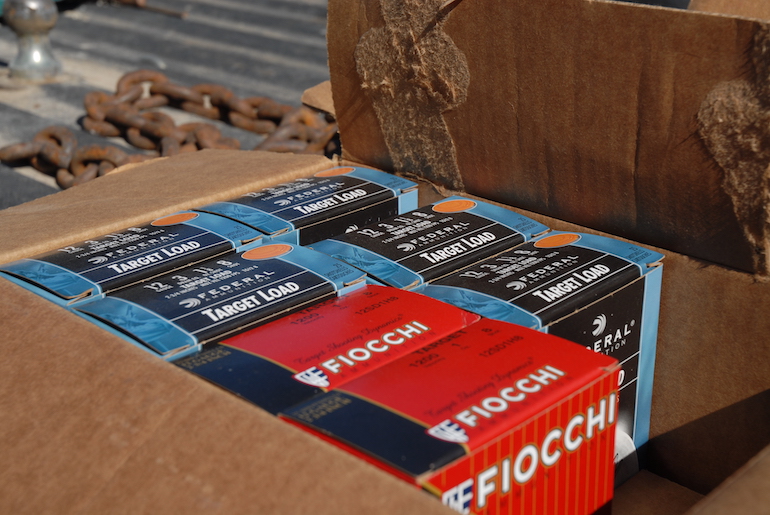
Here are five tips that will help all of us shoot a little better when Dove Season opens up this fall. ((Photo by Lynn Burkhead)
Years ago, I figured out that if I was forced to rely on my own expertise as an outdoor writer, it would be a short-lived career.
I’m something of an everyman sort of hunter and fisherman, one who dabbles in a lot but isn’t an expert in much.
As someone who loves to dove hunt, I followed up on this idea years ago and searched out a Texas dove expert to pick his brain and be ready for the Sept. 1 opener.
The dove-hunting expert I’m referring to is late retriever trainer Steve Stidham, a gentleman who died in untimely fashion a few years ago at the age of 57.
Rummaging through some old file boxes in my garage recently, I found the notes I took during that long-ago interview with the Hunt County resident.
When I read back through them, I found Stidham’s advice—coming from someone who limited out on opening day doves for more than 20 consecutive years—was still rock-solid and worth a second look today.
One part of Stidham’s advice centered around how to get better at efficient shotgun shooting in a dove field. Because even if you’ve found the best field in the county for opening day, it might all be for naught if you can’t shoot very well.
Here are four tips that Stidham gave, plus one that I’m going to add in, advice that will help all of us shoot a little better when the season opens up this fall:

1. Get the Right Shotgun
This tip is one that many wingshooting experts give, particularly when it comes to finding and using a properly fitting shotgun, oftentimes a scattergun that a gunsmith has tailored to the physical dimensions of a given shotgun owner.
But while that’s true, there’s also the idea of getting the gun right in terms of its gauge. And that’s something to which Stidham gave some careful thought, too.
“You want to use a gun that fits the shooter properly in 12, 20, or 28 gauge,” he said.
You might notice there’s a couple of popular gauges missing there, including the 16-gauge, which has been making something of a comeback in recent years with guns like Browning’s A5 Sweet 16 coming to market.
But what’s also missing is the .410-gauge and that’s not by mistake either.
“I say don’t use a .410,” said the late Stidham. “The 67-gauge has a ragged pattern and it is very inefficient. It is an expert’s gun. But not a gun for the kids or the rookies.”
What is the 67-gauge? Well, technically, despite most people saying that a shotgun is a “.410 gauge,” that’s not true. It’s actually a .410 bore shotgun, the gun being the exception to the industry’s standard gauge designations for scatterguns.
In other words, from what I’m able to glean from a variety of forums and websites dedicated to shotgun shooting, this particular shotgun choice has an actual bore diameter, or caliber, of 410/1000ths of an inch.
Since the shotgun gauge definition references the number of balls (produced by a 1-lb. piece of lead) that can pass through a shotgun barrel’s diameter (i.e. 12 through a 12-gauge, 20 through a 20-gauge, 28 through a 28-gauge, etc.), the .410 would actually be in the neighborhood of a 67- or 68-gauge if that’s the definition that was being used here.
But it’s not, and I digress. The point here is that in this late expert’s mind—and in the minds of other wingshooting experts, too—the .410 isn’t a shotgun that should accompany an inexperienced shooter to the hunting field. It’s a recipe for crippling birds in the hands of such wingshooters, not to mention an enthusiasm killing experience waiting to happen.
2. Get the Right Choke
Once a hunter has a properly fitting shotgun, the late Stidham then had some definite thoughts on what choke should be screwed into the end of that scattergun.
And while many hunters opt for more constricting chokes in an effort to extend effective shooting ranges, the late dove hunting expert from Wolfe City, Tex., didn’t go along with that line of thinking.
“I recommend skeet chokes or improved cylinders,” said Stidham. “Stay away from modified and full chokes.”
One reason for Stidham’s belief in using more open chokes and produce wider pattens is that he limited himself to shots at doves in relatively close range. It was more ethical, and in the end, more efficient at putting doves into the back of a game vest.
“I try to take them in skeet fashion with a skeet gun, skeet tubes (chokes), and #9 shot,” he said. “That works real effectively. The radius of a skeet field is 21 yards and that’s where I want to be taking that shot at the dove.”

3. Get the Right Ammo
As noted above, another component of the late hunt master’s consistent wingshooting success was using better shotshell ammunition than most dove hunters do, those who may opt for the cheapest bargain basement loads sold at their favorite box store.
While plenty of doves are taken each fall using such loads in #7 ½ and #8 sizes, Stidham opted for a better dove-killing shotshell load.
“I recommend trap loads in #9 shot sizes,” he said. “If you don’t reload, you’re still hunting with shells that are better than the (bargain) dove/quail loads because the trap loads simply have better components making them up.
“My recommendation is high-brass, high-velocity loads in #9,” he continued. “It has an 1/8th ounce more shot than a (low brass) trap load and a 1/4 ounce more than the standard dove/quail load does.”
While he admitted those shells—he preferred Fiocchi—were a little harder to come by in local stores back then, the better shooting experience they helped provide was worth the effort it took to find them. With today’s online possibilities, finding #9 shotshells from Fiocchi, Remington, Federal, Winchester, Rio, and other manufacturers is quite a bit easier.
4. Get the Right Safety Gear
As a former firefighter, Stidham believed no assemblage of wingshooting gear loaded into the back of a pickup truck was ever complete until a shooter possessed perhaps the most important piece of equipment that could be on the list.
“Another thing I’m a big advocate of is shooting glasses,” he said. “We’ve all been sprinkled on opening day and I’m a big believer in them. I wouldn’t think of going out without them.
“In fact, I never go afield without my shooting glasses and that’s particularly true when you’re dove hunting around a lot of people who aren’t a part of your shooting party.”
While he didn’t mention hearing protection for a dove hunter, as a wingshooter now entering his mid-50s and with a number of dove seasons behind me, I certainly will.
From simple foam ear plugs to the more expensive electronic hearing protection devices that must be fitted to an individual’s ear canal, either guard your ability to hear now or be prepared to try and fix it—if possible—with expensive hearing aids later.
5. Get the Right Practice
In my interview with Stidham a number of years ago, he didn’t mention much in the way of pre-season practice efforts.
Maybe that was because he shot skeet regularly, so his shotgun shooting skills stayed honed at a razor’s sharp edge.
But most shotgunners don’t shoot clay pigeons regularly via the trap or skeet range, or perhaps at a five-stand sporting clays setup. If you do shoot such clay pigeon games regularly, you can skip this last tip, I suppose.
But if you’re like me and don’t shoot regularly in the offseason, spend a weekend or two working on your shooting skills before dove season starts.
Living in an area with few commercial shotgun shooting ranges available, I’ll head out to my father-in-law’s Back 40 pasture with my sons, a box or two of clay pigeons, and a trap thrower. Our process is simple—arm up with some easy, cream-puff shots, build some confidence, and then start serious work on the difficult shots we struggle with each year.
Does such preseason practice work? Well, I’m hardly a dead-eye wingshooting wonder afterwards, but such practice sessions certainly don’t hurt. The rust gets knocked off the end of the barrel, the kinks in shooting form get worked out, and muscle memory and hand-eye coordination gradually return.
Hopefully in time for the Sept. 1 dove season opener in Texas, a hunting holy day if there ever was one.
And with a little luck on that warm early autumn day, I’m not running out of unfired shells but instead am trying to remember the latest recipe I’ve read at Game and Fish for how to cook up a limit of doves in the back of my vest.
I may never match Stidham’s standard of 20-plus opening days with a limit, but I’m sure going to keep trying.








